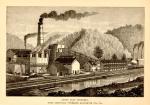![header=[Marker Text] body=[First successful use of raw bituminous coal in place of charcoal, 1846; and of unmixed Lake Superior iron ore in 1856. Built 1845 by Vincent and Himrod; named for Henry Clay. Abandoned in 1861. The site is 2 miles away.] sign](http://explorepahistory.com/kora/files/1/10/1-A-2C1-139-ExplorePAHistory-a0k3h4-a_450.jpg)
Mouse over for marker text
Name:
Clay Furnace
Region:
Lake Erie Region
County:
Mercer
Marker Location:
U.S. 62 W of Charleston
Dedication Date:
January 20, 1949
Behind the Marker
Iron furnaces fueled with bituminous coal and coke fostered the massive growth of the bituminous coal industry in western Pennsylvania, particularly in the area of the Pittsburgh seam (see  First Mining of Pittsburgh Coal), during the late nineteenth and early twentieth century. A few furnaces, including Clay Furnace, used raw bituminous coal; however, by the early twentieth century most iron furnaces employed coke made from bituminous coal. Indeed, bituminous coke superseded charcoal and anthracite coal as the principal fuel for Pennsylvania iron furnaces.
First Mining of Pittsburgh Coal), during the late nineteenth and early twentieth century. A few furnaces, including Clay Furnace, used raw bituminous coal; however, by the early twentieth century most iron furnaces employed coke made from bituminous coal. Indeed, bituminous coke superseded charcoal and anthracite coal as the principal fuel for Pennsylvania iron furnaces.
Clay Furnace was one of a handful of iron furnaces that used raw bituminous coal. B. B. Vincent and David Himrod of Erie built the furnace in 1845 and named it after Henry Clay, a Kentucky Senator who advocated internal improvements in the United States. The furnace started using charcoal, which was the predominant fuel for iron furnaces in Pennsylvania. Vincent and Himrod, however, soon switched to using raw bituminous coal, which was plentiful and burned hotter than charcoal.
In 1850 Clay Furnace was one of only seven Pennsylvania furnaces that used raw bituminous coal. In 1851 Vincent and Himrod sold the furnace to the Sharon Iron Company, who in turn sold it to the Iron Mountain Furnace Company about 1854. This last firm changed from using local iron ore to ore shipped from Lake Superior mines, marking the beginning of Pennsylvania furnaces' use of this important ore source.
Few iron furnaces utilized raw bituminous coal as fuel because raw coal generates less heating power than does bituminous coke. Coke is the product of burning coal under controlled conditions to expel impurities which impede combustion, leaving a higher proportion of combustible carbon. Beginning in the early nineteenth century, ironmasters attempted to use bituminous coke in place of charcoal. Isaac Meason first employed coke about 1817 at his puddling and rolling mill in Plumsock, Fayette County (see Meason House).
Meason House).
Other ironmasters, including those at Karthaus Furnace in Clearfield County, attempted to use coke in iron furnaces during the 1830s but failed. Ironmasters had to overcome several challenges before they could successfully adopt coke. First, they had to obtain coke with fewer impurities that contaminated iron during smelting.
Karthaus Furnace in Clearfield County, attempted to use coke in iron furnaces during the 1830s but failed. Ironmasters had to overcome several challenges before they could successfully adopt coke. First, they had to obtain coke with fewer impurities that contaminated iron during smelting.
By the 1840s, coal mines produced higher-quality coke in beehive coke ovens using Pittsburgh-seam coal. Second, ironmasters needed a larger market for iron manufactured with coke, since coke iron had qualities different from charcoal iron. This market materialized during the 1850s with the growth of demand for iron rails, boilerplate for steam engines, and castings. The construction of railroad lines into western Pennsylvania also provided access to expanding markets.
coke ovens using Pittsburgh-seam coal. Second, ironmasters needed a larger market for iron manufactured with coke, since coke iron had qualities different from charcoal iron. This market materialized during the 1850s with the growth of demand for iron rails, boilerplate for steam engines, and castings. The construction of railroad lines into western Pennsylvania also provided access to expanding markets.  Clinton Furnace used Pittsburgh-seam coke in 1859-1860 very successfully and helped prove that coke was a superior fuel.
Clinton Furnace used Pittsburgh-seam coke in 1859-1860 very successfully and helped prove that coke was a superior fuel.
The iron and steel industry's demand for coke drove the expansion of mining in western Pennsylvania, especially in the Pittsburgh seam. Furnaces fueled with coke made more iron at lower cost than charcoal- or anthracite-fueled furnaces did. In 1875 bituminous-coke furnaces surpassed the output of anthracite furnaces in Pennsylvania. Iron and steel companies continued to expand the output and reduce the production costs of bituminous coke furnaces during the late nineteenth century.
By 1900, seventy coke furnaces had seventy-one percent of the state's iron-making capacity, while seventy anthracite furnaces had only twenty-eight percent of capacity (charcoal furnaces supplied the other one percent of capacity). Even in eastern Pennsylvania, where anthracite furnaces were concentrated near the anthracite fields, bituminous coke came to dominate by 1900.
The move from charcoal and anthracite to bituminous coke in iron smelting bypassed Clay Furnace. The Iron Mountain Furnace Company abandoned the furnace in 1861 because it could not compete with bituminous-coke furnaces. The future of the iron and steel industry lay with bituminous-coke furnaces.
Clay Furnace was one of a handful of iron furnaces that used raw bituminous coal. B. B. Vincent and David Himrod of Erie built the furnace in 1845 and named it after Henry Clay, a Kentucky Senator who advocated internal improvements in the United States. The furnace started using charcoal, which was the predominant fuel for iron furnaces in Pennsylvania. Vincent and Himrod, however, soon switched to using raw bituminous coal, which was plentiful and burned hotter than charcoal.
In 1850 Clay Furnace was one of only seven Pennsylvania furnaces that used raw bituminous coal. In 1851 Vincent and Himrod sold the furnace to the Sharon Iron Company, who in turn sold it to the Iron Mountain Furnace Company about 1854. This last firm changed from using local iron ore to ore shipped from Lake Superior mines, marking the beginning of Pennsylvania furnaces' use of this important ore source.
Few iron furnaces utilized raw bituminous coal as fuel because raw coal generates less heating power than does bituminous coke. Coke is the product of burning coal under controlled conditions to expel impurities which impede combustion, leaving a higher proportion of combustible carbon. Beginning in the early nineteenth century, ironmasters attempted to use bituminous coke in place of charcoal. Isaac Meason first employed coke about 1817 at his puddling and rolling mill in Plumsock, Fayette County (see
Other ironmasters, including those at
By the 1840s, coal mines produced higher-quality coke in beehive
The iron and steel industry's demand for coke drove the expansion of mining in western Pennsylvania, especially in the Pittsburgh seam. Furnaces fueled with coke made more iron at lower cost than charcoal- or anthracite-fueled furnaces did. In 1875 bituminous-coke furnaces surpassed the output of anthracite furnaces in Pennsylvania. Iron and steel companies continued to expand the output and reduce the production costs of bituminous coke furnaces during the late nineteenth century.
By 1900, seventy coke furnaces had seventy-one percent of the state's iron-making capacity, while seventy anthracite furnaces had only twenty-eight percent of capacity (charcoal furnaces supplied the other one percent of capacity). Even in eastern Pennsylvania, where anthracite furnaces were concentrated near the anthracite fields, bituminous coke came to dominate by 1900.
The move from charcoal and anthracite to bituminous coke in iron smelting bypassed Clay Furnace. The Iron Mountain Furnace Company abandoned the furnace in 1861 because it could not compete with bituminous-coke furnaces. The future of the iron and steel industry lay with bituminous-coke furnaces.
Beyond the Marker







